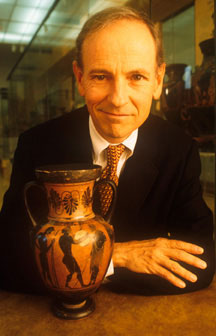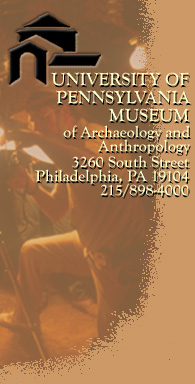| |
SECURITY CONCERNS, PLUS CHEATING AND SCANDALS, ARE
NOTHING NEW AT THE OLYMPICS — ACCORDING TO ANCIENT
OLYMPIC EXPERT DAVID GILMAN ROMANO
Penn Museum
Updates Award-winning Ancient Olympics Website
in
Time for 2004 Olympics in Greece
04/22/2004
 PHILADELPHIA, Spring 2004—With only
months before the summer 2004 Olympics in Athens, Greece
begin, concern about security for the athletes and
visitors grows. Terrorism and terroristic threats, so
much a part of the world today, have added an unpleasant
new element to the high-profile games. Oh for the simple
days in ancient times, when the Olympics were free of
outcast politics and terroristic threats,
right? PHILADELPHIA, Spring 2004—With only
months before the summer 2004 Olympics in Athens, Greece
begin, concern about security for the athletes and
visitors grows. Terrorism and terroristic threats, so
much a part of the world today, have added an unpleasant
new element to the high-profile games. Oh for the simple
days in ancient times, when the Olympics were free of
outcast politics and terroristic threats,
right?
Not quite so, says Dr. David Gilman
Romano, Senior Research Scientist at the University of
Pennsylvania Museum of Archaeology and Anthropology,
Adjunct Professor of Classical Studies at the University
of Pennsylvania, in Philadelphia, and a leading expert
on the ancient Olympic games.
"The threat of a
terrorist attack at the modern Olympic Games this summer
in Athens is nothing new to scholars who study the
ancient Olympic games," Dr. Romano explained. "Although
there was a long-standing truce established in antiquity
to protect travelers of all kinds going to and returning
from the Olympic Games, there were serious violations of
this truce. On more than one occasion Greek hoplite
soldiers stormed the Sanctuary of Zeus at Olympia. In
one instance they interrupted the pentathlon event of
the Olympic games. Wars were fought between rival Greek
city-states over the control of the
sanctuary."
The allegations of greed, bribes, and
cheating by officials and athletes alike, allegations
that plagued the 2000 Olympics in Sydney, Australia and
the 2002 Olympics in Salt Lake City, Utah, however, were
certainly symptoms of modern-world
corruption--yes?
Of corruption: "It’s an age old
tradition," notes Dr. Romano. And when he says old, he
means OLD—2780 years or so old, starting back at the
very beginning of the Olympics.
While there is no
known evidence of athletes taking performance-enhancing
drugs to win in ancient Greek times, breaking the rules
at Olympia, according to Dr. Romano, was well known. In
fact, in lieu of statues depicting victorious athletes,
statues of Zeus, complete with written apologies in
stone, were sometimes erected at the games to make
examples of cheating athletes.
"Even the ancient
myth that describes the origins of the Olympic games is
a tale of cheating and bribery," Dr. Romano noted. The
Greek poet Pindar tells that young Pelops accepts the
king's challenge to a chariot race to win the hand of
the king's daughter. To ensure his victory, Pelops
bribes the king's charioteer to replace the bronze
linchpin in the wheel of the king's chariot with one
made of wax. To celebrate his victory, Pelops
establishes the Olympic Games. This myth was depicted
larger than life in sculpture in the pediment of the
Temple of Zeus at Olympia.
Other examples of
ancient greed, bribes and scandals? In A.D. 67, Roman
Emperor Nero paid one million "sesterces" to the council
of judges overseeing the Olympic games, persuading them
to hold Olympic games out of sequence and in a year not
scheduled for the contests so he could compete and win.
Nero received what would be the equivalent of six gold
medals in today's Olympics.
Dr. Romano knows what
he's talking about. He is author of the Penn Museum’s
popular, award-winning website "The Real Story of the
Ancient Olympic Games": http://www.museum.upenn.edu/olympics
The site, chock full of sometimes myth-breaking facts
about the early Olympics in Greece, has just been
updated in anticipation of summer 2004 interest. One new
section includes modern myths about the ancient
Olympics, while another section boasts images from the
ancient Olympia stadium. Yet another lists the most
famous athletes from ancient times and their
accomplishments.
In addition to the ancient
Olympics website, Penn Museum displays a perennial
selection of ancient Greek artifacts pertaining to
athletics, games and the Olympics in the recently
refurbished "Ancient Greek World" gallery, part of
"Worlds Intertwined: Etruscans, Greeks and Romans"
Mediterranean world suite of galleries. On display are
about a dozen items, including ancient vases depicting
athletes in a variety of sports, and an ancient
"strigil" used by athletes to scrape oil and sand from
their bodies.
An archaeologist who has worked for
many years at Corinth in Greece, Dr. Romano's current
excavation work is in the ancient Greek region of
Arcadia: the Mt. Lykaion Excavation and Survey Project,
a Penn Museum/University of Arizona/Fifth Ephorate of
Prehistoric and Classical Antiquities, Sparta joint
effort. Renowned as a sanctuary of the Greek god Zeus,
the site features an ancient stadium and hippodrome in
which athletic games for the Lykaion festival were held.
The Sanctuary of Zeus at Mt. Lykaion is only 17 miles
from its more famous neighbor, the Sanctuary of Zeus at
Olympia. A website details the project: http://corinth.sas.upenn.edu/lykaion/lykaion.html
Dr.
Romano is author of a script for a 1999 audiotape,
"Greed, Bribes and Scandals: The Ancient Olympics," and
a 1996 videotape, "The Ancient Olympics: Athletes, Games
and Heroes," both produced by the Institute for
Mediterranean Studies, Cincinnati mailto:studies@usa.net
He also has taught a popular Penn course on "Ancient
Athletics" since 1983. He has published through the
American Philosophical Society an award-winning book,
"Athletics and Mathematics in Archaic Corinth: The
Origins of the Greek Stadion." A former physical
education instructor, track coach and distance runner in
college and graduate school, he was selected, in 1973,
to attend the International Olympic Academy in Olympia,
Greece as a representative of the U.S. Olympic
Committee. He continues to coach a youth cross country
and track team, the Dashers.
Olympic organizers
are finding the history of the games increasingly
important—and relevant. Several years ago, Dr. Romano
was contacted by the Salt Lake Organizing Committee for
the Olympic Winter Games of 2002. The committee wanted
to make cultural programs an integral part of the 2002
Olympic games, and members wanted to know if this would
be a great departure from the ancient games. He supplied
the Committee with an essay—posted on the official
Olympic website—outlining the many ways that music,
dance, art and athletics came together at the ancient
Olympics. His perspective on adding cultural events to
the programming mix: do it! After all, it was nothing
new.
The University of Pennsylvania Museum of
Archaeology and Anthropology, 3260 South Street in
Philadelphia, is dedicated to the study and
understanding of human history and diversity. Founded in
1887, the Museum has sent more than 400 archaeological
and anthropological expeditions to all the inhabited
continents of the world. With an active exhibition
schedule and educational programming for children and
adults, the Museum offers the public an opportunity to
share in the ongoing discovery of humankind's collective
heritage. The Museum’s website is http://www.museum.upenn.edu/
For general information, the phone number is
215/898-4000.
# # #
TO THE
MEDIA: IMAGES, INCLUDING 300 DPI JPEGS OF ANCIENT
GREEK ARTIFACTS DEPICTING ANCIENT ATHLETIC EVENTS, FROM
THE MUSEUM'S "ANCIENT GREEK WORLD" EXHIBITION, AND
IMAGES OF ANCIENT GREEK STADIUMS, COURTESY OF DAVID
ROMANO, ARE AVAILABLE UPON REQUEST BY CALLING THE PUBLIC
INFORMATION OFFICE AT 215.898.4045 OR EMAIL
PKOSTY@SAS.UPENN.EDU
View
Exhibitions, Events, and Announcements
Press
Releases |
